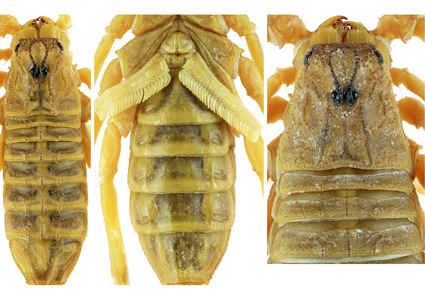Abstract
Following Graham et al. (2019), the recently described desert species Olivierus gorelovi (Fet et al., 2018) from Central Asia is herein restricted to Turkmenistan and southern Uzbekistan. In this contribution, we described other populations formerly included in O. gorelovi as three new species: O. mikhailovi sp. n. (southern Kazakhstan, Uzbekistan), O. tarabaevi sp. n. (Kazakhstan) and O. voldemari sp. n. (Uzbekistan: Ferghana Valley).
References
Atamuradov, K.I. (1994) Paleogeography of Turkmenistan. In: Fet, V. & Atamuradov, K.I. (Eds.), Biogeography and Ecology of Turkmenistan. Kluwer Academic Publishers, Dordrecht, pp. 49–64. https://doi.org/10.1007/978-94-011-1116-4_4
Burtman, V.S., Skobelev, S.F. & Molnar, P. (1996) Late Cenozoic uplift on the Talas-Ferghana fault, the Tien Shan, central Asia. GSA Bulletin, 108 (8), 1004–1021. https://doi.org/10.1130/0016-7606(1996)108%3C1004:LCSOTT%3E2.3.CO;2
Fet, V. (1989) A catalogue of scorpions (Chelicerata: Scorpiones) of the USSR. Rivista del Museo Civico di Scienze Naturali “Enrico Caffi”, 13 (1988), 73–171.
Fet, V. (1994) Fauna and zoogeography of scorpions (Arachnida: Scorpiones) in Turkmenistan. In: Fet, V. & Atamuradov, K.I. (Eds.), Biogeography and Ecology of Turkmenistan. Kluwer Academic Publishers, Dordrecht, pp. 525–534. https://doi.org/10.1007/978-94-011-1116-4_31
Fet, V., Kovařík, F., Gantenbein, B., Kaiser, R.C., Stewart, A.K. & Graham, M.R. (2018) Revision of the Mesobuthus caucasicus complex from Central Asia, with descriptions of six new species (Scorpiones: Buthidae). Euscorpius, 255, 1–77. https://doi.org/10.18590/euscorpius.2018.vol2018.iss255.1
Fet, V. & Lowe, G. (2000) Family Buthidae. In: Fet, V., Sissom, W.D., Lowe, G. & Braunwalder, M.E. (Eds.), Catalog of the Scorpions of the World (1758–1998). New York Entomological Society, New York, 54–286.
Gantenbein, B., Fet, V. & Gromov, A.V. (2003) The first DNA phylogeny of four species of Mesobuthus Vachon, 1950 (Scorpiones: Buthidae) from Eurasia. The Journal of Arachnology, 31, 412–420. https://doi.org/10.1636/H01-23
Graham, M.R., Ayrey, R.F. & Bryson Jr., R.W. (2012a) Multivariate methods support the distinction of a new highland Vaejovis (Scorpiones: Vaejovidae) from the Sierra de los Ajos, Mexico. The Journal of Arachnology, 40 (3), 281–290. https://doi.org/10.1636/Ha11-78.1
Graham, M.R., Myers, E.A., Kaiser, R.C. & Fet, V. (2019) Cryptic species and co-diversification in sand scorpions from the Karakum and Kyzylkum deserts of Central Asia. Zoologica Scripta, 48 (6), 801–812. https://doi.org/10.1111/zsc.12381
Graham, M.R., Oláh-Hemmings, V. & Fet, V. (2012b) Phylogeography of co-distributed dune scorpions identifies the Amu Darya River as a long-standing component of Central Asian biogeography (Scorpiones: Buthidae). Zoology in the Middle East, 55, 95–110. https://doi.org/10.1080/09397140.2012.10648924
Gromov, A.V. & Kopdykbaev, Ye. Ye. (1994) [The fauna of the scorpions and solpugids (Arachnida: Scorpiones, Solifugae) in Kazakhstan]. Selevinia, 2(2), 19–23. [in Russian]
Kovařík, F. (2009) Illustrated catalog of scorpions. Part I. Introductory remarks; keys to families and genera; subfamily Scorpioninae with keys to Heterometrus and Pandinus species. Prague: Clairon Production, 170 pp.
Kovařík, F. (2019) Taxonomic reassessment of the genera Lychas, Mesobuthus, and Olivierus, with descriptions of four new genera (Scorpiones: Buthidae). Euscorpius, 288, 1–27. https://doi.org/10.18590/euscorpius.2019.vol2019.iss288.1
Kovařík, F., Fet, V. & Yağmur, E.A. (2020) Further review of Orthochirus Karsch, 1892 (Scorpiones: Buthidae) from Asia: taxonomic position of O. melanurus, O. persa, O. scrobiculosus, and description of seven new species. Euscorpius, 317, 1–79.
Kovařík, F. & Ojanguren Affilastro, A.A. (2013) Illustrated catalog of scorpions. Part II. Bothriuridae; Chaerilidae; Buthidae I. Genera Compsobuthus, Hottentotta, Isometrus, Lychas, and Sassanidotus. Prague: Clairon Production, 400 pp.
Pavlovsky, E.N. (1916a) [Dzhulek, of Perovsky District, Syr-Darya Province, and some biological observations in its environs]. Trudy Imperatorskago Petrogradskago Obshchestva Yestestvoispytatelei [Travaux de la Société impériale des Naturalistes de Petrograd], 47 (1), 27–68. [in Russian]
Pavlovsky, E.N. (1916b) Quelques observations biologiques sur les scorpions de la famille des Buthidae. Comptes rendus de la Société biologique [Petrograd], 81, 243–246.
Stahnke, H.L. (1971) Scorpion nomenclature and mensuration. Entomological News, 81, 297–316.
Sun, D. & Sun, Z.-N. (2011) Notes on the genus Mesobuthus (Scorpiones: Buthidae) in China, with a new species. The Journal of Arachnology, 39, 59–75. https://doi.org/10.1636/Ha10-36.1
Sun, D. & Zhu, M. (2010) A new species of the genus Mesobuthus (Scorpiones: Buthidae) from Xinjiang, China. ZooKeys, 37, 1–12. https://doi.org/10.3897/zookeys.37.301
Teruel, R., Kovařík, F. & Fet, V. (2018) Revision of the Central Asian scorpion genus Anomalobuthus Kraepelin, 1900, with descriptions of three new species and a generic synonymy (Scorpiones: Buthidae). Euscorpius, 270, 1–45. https://doi.org/10.18590/euscorpius.2018.vol2018.iss270.1
Vachon, M. (1974) Études des caractères utilisés pour classer les familles et les genres de Scorpions (Arachnides). 1. La trichobothriotaxie en arachnologie. Sigles trichobothriaux et types de trichobothriotaxie chez les Scorpions. Bulletin du Muséum national d’Histoire naturelle, Paris, 3e série. n°140, Zoologie. 140, 857–958.


